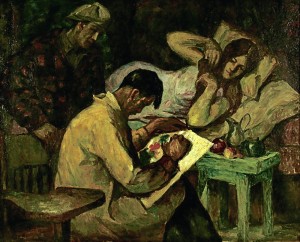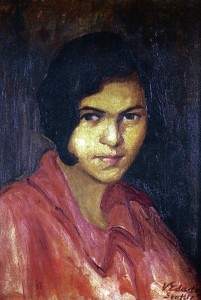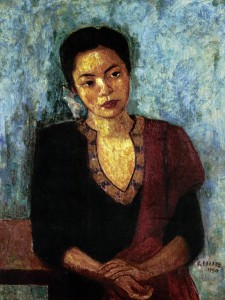
At the beginning of the 20th century, a revolution was brewing in Europe. It was the modernist assault in science and technology, literature and philosophy, music and dance, visual arts and architecture, film.
“Since the birth of civilization, no age has broken with tradition more radically or more self-consciously than the 20th century,” says culture historian Gloria Fiero.
The stirrings were particularly felt in the arts—the revolt against convention and tradition—and in so short a time the triumph of modernism was complete.
This was what Filipino artist Victorio Edades saw in the Armory Show (or “The International Exhibition of Modern Art”), when the touring exhibit of over a thousand pieces arrived in Seattle in 1922, while Edades was studying architecture and painting at University of Washington.

He was said to have been especially drawn to the works of the Postimpressionists, particularly Cézanne.
Upon his return to the country in 1928, he brought what he saw to the local art world by holding a homecoming exhibit of 30 recent works at the Philippine Columbian Club in Manila, with the help of sculptor Guillermo Tolentino.
It was the Filipino public’s introduction to modern art, when popular taste was still wallowing in classicism, academic art and romantic pastorals. Like the Armory Show, Edades’ exhibit was reportedly met with “shock and disdain,” and not a single painting was sold.

Many of those from that historic show can be seen in “Images of Nation: Victorio Edades,” ongoing until July 29 on the third floor of Ayala Museum, Greenbelt Park, Makati City. These include the iconic pieces “The Builders,” “The Sketch” and “The Wrestlers.”
Seminal works of modernism
The first quarter of the 20th century was certainly an interesting time, etched in art history as a revolutionary period—when most of the major art movements were inaugurated.
Says Fiero: “Early modern artists probed the tools and techniques of formal expression more fully than any artists since the Renaissance.”
Consider the seminal works that launched those movements: Cubism—Picasso’s 1907 oil-on-canvas “Les Demoiselles d’Avignon” and Braque’s 1914 collage on paper “Still Life on a Table.”
Abstraction—Kandinsky’s 1914 oil-on-canvas “Panel for Edwin Campbell” No. 1; Malevich’s 1918 oil-on-canvas “Suprematist Composition: White on White”; and Mondrian’s 1921 oil-on-canvas “Composition in Red, Yellow, Blue and Black.”
Futurism—Boccioni’s 1913 bronze sculpture “Unique Forms of Continuity in Space” and Duchamp’s 1912 oil-on-canvas “Nude Descending a Staircase.”
Fauvism—Matisse’s 1909 oil-on-canvas “The Dance.” Expressionism—Kirchner’s 1913 oil-on-canvas “Street, Berlin.”
Metaphysical Art—De Chirico’s 1911 oil-on-canvas “The Nostalgia of the Infinite” and Chagall’s 1911 oil-on-canvas “I and the Village.”
Dada—Duchamp’s 1917 readymade piece “Fountain (Urinal).” Constructivism—Popova’s 1922 set design for “Le Cocu Magnifique.”
Surrealism—Miró’s 1926 oil-on-canvas “Person Throwing a Stone at a Bird” and Magritte’s 1928 oil-on-canvas “The False Mirror.”
Informing those works was the credo that “art must be subversive—that it must defy all that is conventional, literal and trite.” It is thought to be heralded by “The Large Bathers,” the 1906 oil-on-canvas by Cézanne (whom Matisse and Picasso acknowledged as “the father of us all”).
But surely the precursor of this new subversion must be that 1893 masterpiece of Expressionism, Munch’s “The Scream.”
Those artists shared the belief that they must “evoke the essential and intrinsic qualities of the subject rather than describe its physical properties.” In pointing out the concept of “birdness” and “the essence of flight” in his bronze sculpture “Bird in Space,” Brancusi was only summing up the dictum of modern art: What is real is not the external form, but the essence of things.
Modernists vs. conservatives
Our first contact with modern art happened at about the same time as the American public’s, when Edades saw that Armory Show. But it took him a few decades before his ideas could be fully accepted by his countrymen.
Through the ’30s and ’40s, he waged a polemical war with the conservatives, as represented by genre painter Fernando Amorsolo and Tolentino, the classicist sculptor who, ironically, helped him mount his seminal show at the Philippine Columbian.
Meanwhile, he had surrounded himself with kindred spirits, constituting the group that has come to be known as the Thirteen Moderns: the triumvirate of Edades, Galo Ocampo and Carlos “Botong” Francisco, plus Vicente Manansala, Cesar Legaspi, HR Ocampo, Diosdado Lorenzo, Ricarte Purugganan, José Pardo, Demetrio Diego, Arsenio Capili, Bonifacio Cristobal and Anita Magsaysay-Ho. (They were the inspiration of former Cultural Center of the Philippines artistic director Roberto Chabet when he put up the 13 Artists Award.)
Budding local artists would do well to see the exhibit “Images of Nation,” now on its last week, to appreciate the beginnings of modern art in the country. This is the third in a series of retrospective shows organized by Ayala Museum to highlight the works of our National Artists for the Visual Arts (after Vicente Manansala in 2010 and José Joya last year).
The distorted figures and rough texture of modernism are here. And so is the composition of groupings obviously inspired by Matisse and Cézanne, as in “The Wrestlers” and “Picnic.”
Edades’ color tonality is often earthy, but sometimes it can attain the bold colorism of the Fauvists, as in “Portrait of a Lady,” “Mora Girl” and “Modern Maria Clara.” The cool harmony can range from Velázquez to Gauguin, while the warm harmony can evoke the Impressionists, as in “River View at Bas Samois.”
Edades is acknowledged as the Father of Philippine Modern Art. He was proclaimed National Artist in 1976, the award citation describing him as “the original iconoclast of Philippine art.”
And: “He changed the direction of Philippine painting decisively, ending the parochial isolation of Philippine art and placing it in the mainstream of international culture.”

